We’re really excited about what we’re doing over here in the Goonhammer Historicals team with our Flower Wars project. It’s an exciting thing, being involved in designing a brand new game. It’s not one that I ever thought I’d get involved in, to be honest, because if there’s one thing that’s been a defining characteristic of my tabletop experience, it’s that I’m not good at games. Luckily, that turned out not to be my job.
When we started talking about the Flower Wars project in the Goonhammer Historicals Bastion Fort, one of the first things we did was look at our varied areas of interest, expertise and even our resumes to work out what we could contribute to the team. HardyRoach and Lupe are our Games Designers. Ilor wrote a cracking kit review and building guide to help you turn your Wargames Atlantic Aztecs kit into a force ready to test out our game.
I’d like to think my strengths lie in finding stuff out. Over the last year I’ve taught myself all about the Napoleonic period, possibly, if you ask my wife, far, far too much about it to the extent I’m now occasionally found staring out over the garden thinking about Waterloo with one hand in my jacket.
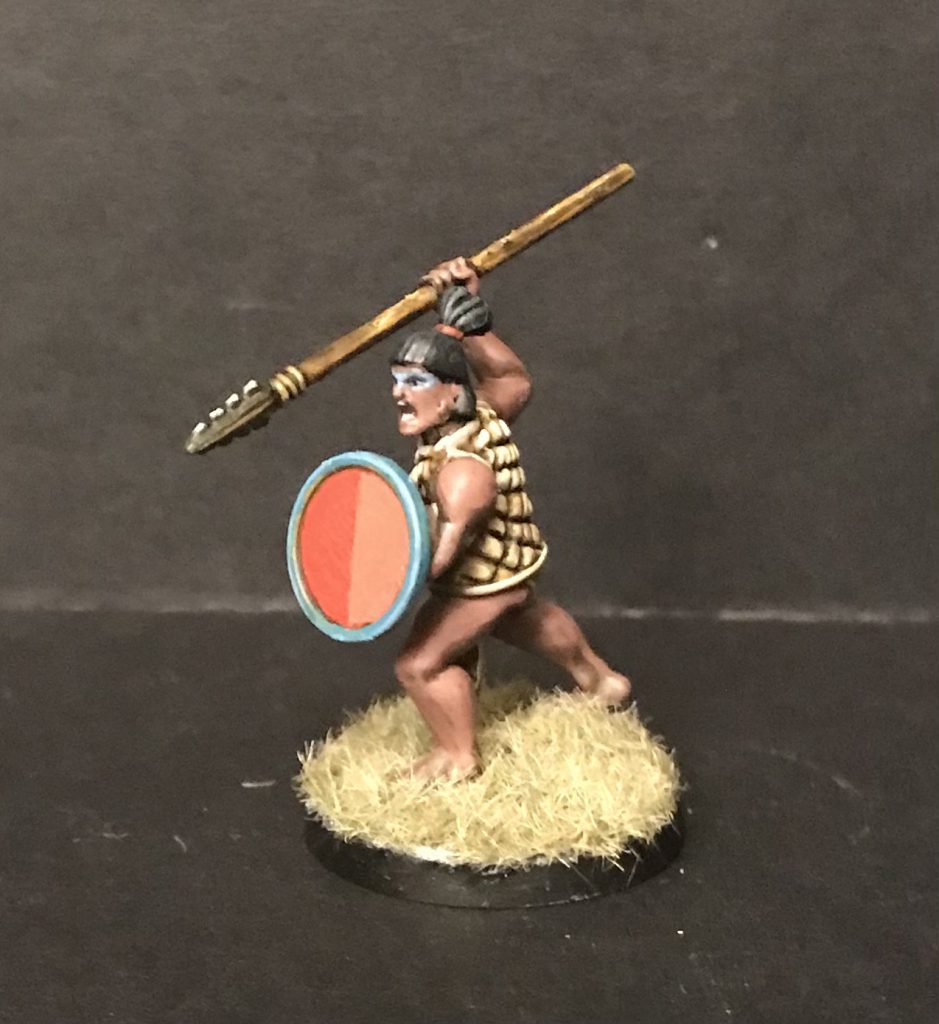
Because we’re approaching a new topic – and one that is “known” to wargamers through a very limited set of ideas about the Aztecs (if at all), we wanted to dig into the Flower Wars a bit more, and look not just at ideas for troop types and mechanics but to arrive at a level of understanding that would set us up for “ludonarrative harmony” where the mechanics of the game reflect the historical reality. That meant doing some serious research. This article is about the process of doing that research, that culminated in our first Game Design article. If you want to see what we’ve found out, you might need to wait until the game comes out!
A Quick Note – you’ll see Aztec and “Aztec” used for a little bit before being largely replaced – you’ll see why later!
First Principles
Though I have a research background, I’d never formally studied the Aztecs. I’d covered a bit of the archaeology of the Oaxaca valley when at University, but at this point that was – gulp – 15 years ago, so I very much went back to first principles on how to research and how to do relevant research. The first big question was “What do we need for this game to work?”, and talking to the team we decided on:
- A basic understanding of the culture – the “Aztecs”- that owned the phenomenon – the Flower Wars – that we wanted to explore. This provides setting, context and some game related information.
- Specific understanding of the Aztec way of warfare – who fought, what with, why and where. This provides a lot more specific game related information – we are creating a wargame, so we need that war info.
- Knowledge of any glaring pitfalls, issues or misconceptions around the “Aztecs”. This is vitally important so that we can avoid many of the traps historical games fall into around racism, colonialism, orientalism and identity. The people and cultures who will feature in the game are worthy of our respect and understanding – not only because they are still there today, but because we want to be respectful of those who once existed. It’s a game about them, after all.
- How to pronounce all the key terms we’d present in Nahuatl, the language used by the people we’re writing about. We want to use xōchiyāōyōtl as much as we use Flower War, and Mācuahuitl more than “Club with Obsidian in it”. So really, we should know how to say them!
What we didn’t need was equally important, and that ended up being:
- In depth socio-economic-political understanding of the wider Mesoamerican cultural context. This will inevitably be interesting, and important, but we’re looking at a game set in a specific area at a specific time – understanding the cotton and feather trade in the Mexico valley is not likely to be that vital (it might be though!).
- History of Warfare in the region. This is a wargame, but it’s not about open battle or campaigning or empire-crushing actions. It’s about a very specific type of battle
From Aztec to Mexica
To generate some ludonarrative harmony, we want to situate both the game and the historical instances of Flower War within their context. Starting off, I really had to go back to the beginning with the research, working out the broad strokes of what was happening in Mexico before the European invasion. The first big question was around “Aztec”. It’s a word that we use to describe a culture, indeed a set of cultures, relating to the political situation of central Mexico from the 13th century, but then we’ve also been taught that “Aztec” means the very particular cultural-political situation in Tenochtitlan, the city that – in UK teaching, if it’s covered at all – stands in for the entirety of the Aztec culture. The area we’re talking about is the “Aztec Empire”, the triple alliance of cities/polities – “altepetl” in Nahua – Tenochtitlan, Texcoco and Tlacopan who shared a language and a culture. All of them are now essentially within the Mexico city urban area, but had distinct lineages, cultural variations and leadership. It was news to me that the name Aztec was just something made up by one of the 19th century’s many thousands of European scientific dilettantes – Alexander von Humboldt.
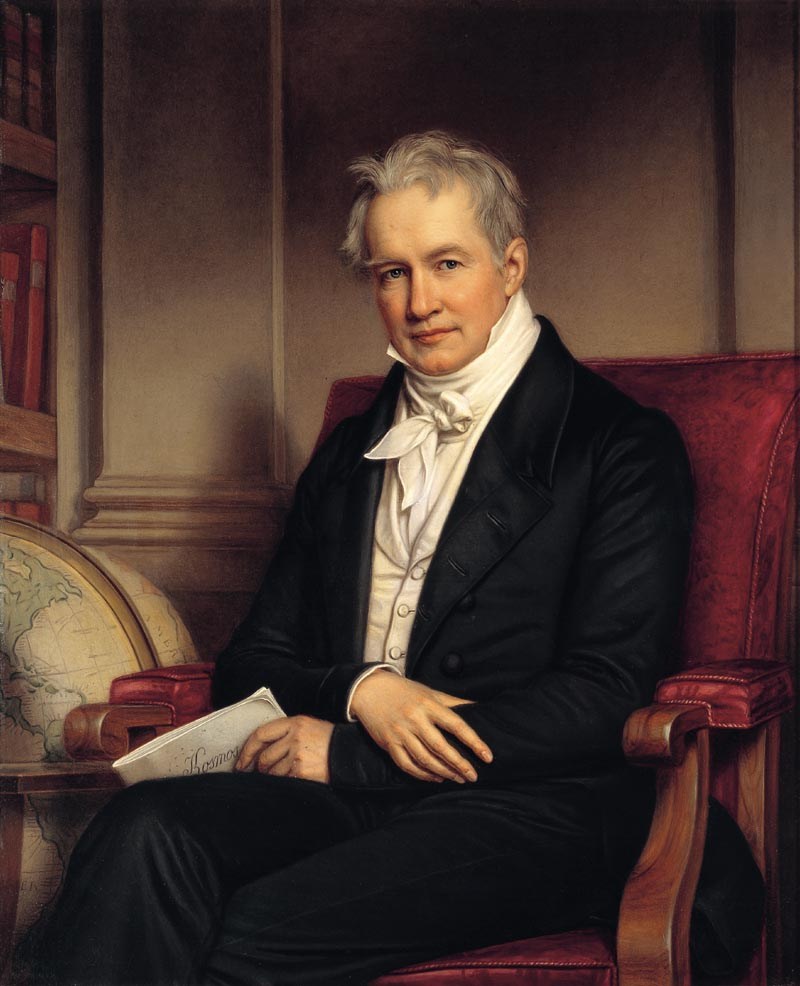
Flower Wars the game is about something that the Aztec Empire did, particularly something that the ruling elites organised, supported and undertook. So this isn’t an “Aztec” game relating to everyone in central Mexico at the time. More properly this is game about the Mexica, because it covers the activities of a cultural-political group of the Nahua people. We’re writing a game about a culture and a people we aren’t part of – that “our” civilisation attempted to annihilate. This is a game about Mexica peoples, so we should – at least – use a name that wasn’t made up by someone who looks exactly like those writing it.
Researching the Flower Wars
We started off with a grab-bag of words and concepts we associated with the Flower Wars. Things like “Formal Warfare” and “prestige” along with more general “Aztec-y” concepts that we have picked up at school or via cultural osmosis, things like “captive”, “sacrifice”, “eagle warrior” and “obsidian”. Our impressions of the Mexica are very much shaped by a legacy of imperialist conquest and orientalist degradation – close your eyes at this point and think “Aztec”, don’t worry, the article will wait.
Ok, are we back? Did you see stepped pyramids? A “priest” possibly in a feather headdress lifting up a human heart to the rising sun? A warrior dressed like an eagle? Gold, gold in amounts to drive a Conquistador mad?
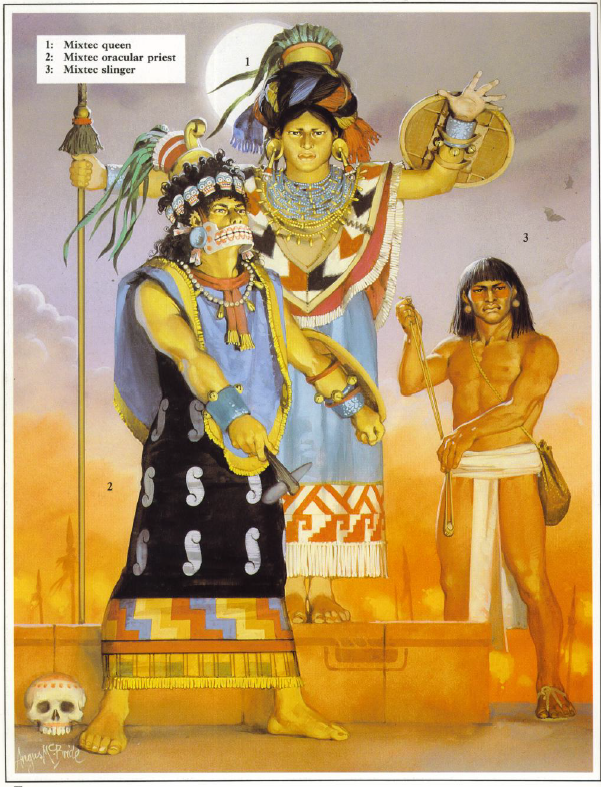
That’s what we’re working with, more or less, isn’t it? When something is so culturally loaded, my first stop is always to try and read, or listen to, the voices of the people I’m trying to research. This is hard with the Mexica largely due to the complete and total cultural annihilation the Spanish attempted, but Camilla Townsend’s Fifth Sun provided the easiest and best access to Mexica sources I will ever get to have without learning Nahuatl or (and this one would probably be easier) Spanish. With Fifth Sun read I attempted to hold what the Mexica thought of themselves – a political hegemony held together with good luck, astute politics, clever diplomatic manoeuvring and a strong military – in the forefront of my thinking about the Flower Wars instead of what the Spanish portrayed them as – murderous savage cannibals who believed the white man was a god – so that I could keep Mexica voices and interpretations in my head as much as possible.
So straight away we’re able to say some things about the Flower Wars and make game-related statements about them:
The Flower Wars were important, so they are a suitable subject for a game
They weren’t a weird, incomprehensible and savage thing, so actions in the game should be under player control
They would have happened in a complex context, and that context would make sense to the Mexica, so mechanics need to reflect that reality
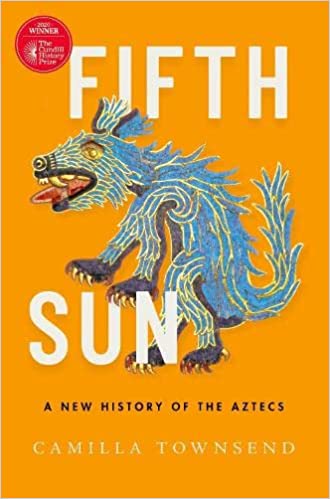
The Man, the Myth, the Hassig
Finding that context meant going straight to the usual first stop on a research trip – Wikipedia. The article on Aztec Warfare – how the Aztecs fought, how they were organised, why they fought, what the flower wars were and all of this key information – was a good beginning, but, like many wikipedia pages on academic subjects, you can look in the references and see that it’s simply a fairly poorly condensed version of one guy’s work – Ross Hassig. A flip through an old Osprey – Aztec, Mixtec and Zapotec Armies – revealed exactly the same reliance on a single source.
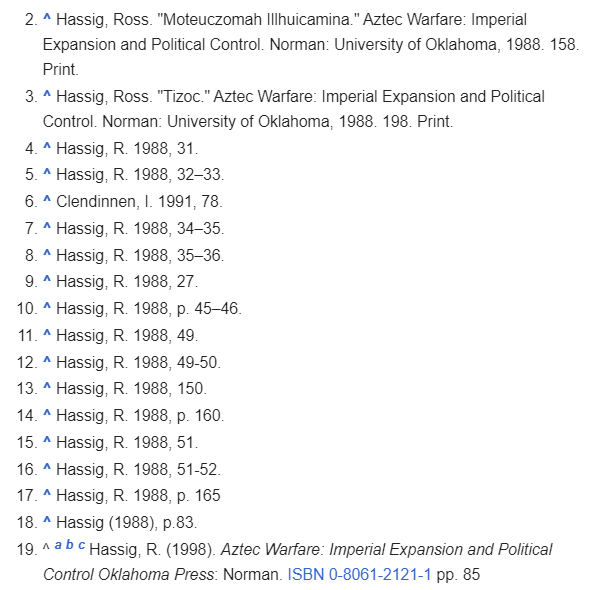 Ross Hassig’s book Aztec Warfare: Imperial Expansion and Political Control seems to be THE book looking at the way the Mexica went to war. It covers all the granular detail we wanted – the rank system, the weapons and equipment of the Mexica, the logistical and strategic organisation that gets Napoleonic nerd me very excited and the role of the warrior within society. It’s also a compelling and easy read. The book goes over some of the older explanations for the Flower Wars, including those recorded very early on:
Ross Hassig’s book Aztec Warfare: Imperial Expansion and Political Control seems to be THE book looking at the way the Mexica went to war. It covers all the granular detail we wanted – the rank system, the weapons and equipment of the Mexica, the logistical and strategic organisation that gets Napoleonic nerd me very excited and the role of the warrior within society. It’s also a compelling and easy read. The book goes over some of the older explanations for the Flower Wars, including those recorded very early on:
“We could easily do so; but then there would remain nowhere for the young men to train, except far from here; and, also, we wanted there to always be people to sacrifice to our gods.”
Andres de Tapia, Conquistador Chronicler, asking Mexica leaders why smaller altepetl had not been conquered
Hassig has a very pragmatic interpretation of why the Flower Wars happened – they were ways of fighting (and winning) battles against an enemy too big or too risky to engage in all out war. Mexica dominance required political, rather than ideological, hegemony, so risking a large war, even if the likelihood of victory was high, was a very risky proposition.
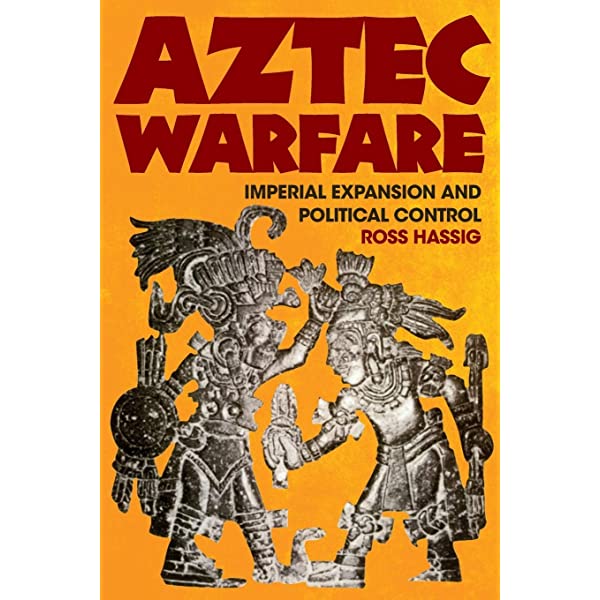
Instead, the Flower Wars could be fought, slowly sapping an altepetl, group of towns or even rival empire, of their best and brightest, forcing them into repeated small conflicts and wearing them down. All research is informed by the researcher’s context, and I can’t help but read this as Hassig bringing the cold war into pre-invasion Mexico. Nevertheless, it gives a solid basis for us understanding the “how” and “why”. This general overview of Mexica warfare allowed us to make a few more statements:
Flower Wars were about tactics within a wider strategy, so our game should focus on tactics not strategy
Mexica weapons and equipment were important to their tactics, so our game should show that
Warriors fought in loose groups, with support and a ranked hierarchy, so our game should include those ranks and a support element
The Flower Wars – in Hassig’s telling at least – were one of several mechanisms where warriors could gain social, political and economic power through combat. Taking captives, feats of daring, strength and cunning, and your actions during a battle contributed to mechanisms whereby noble and commoner warriors could rise through the “ranks” of a social/military system. Taking captives allowed you to be “promoted” through a hierarchy, and that brought huge and important social and economic benefits. Many sections of society participated, and their sons were often raised into the hierarchy.
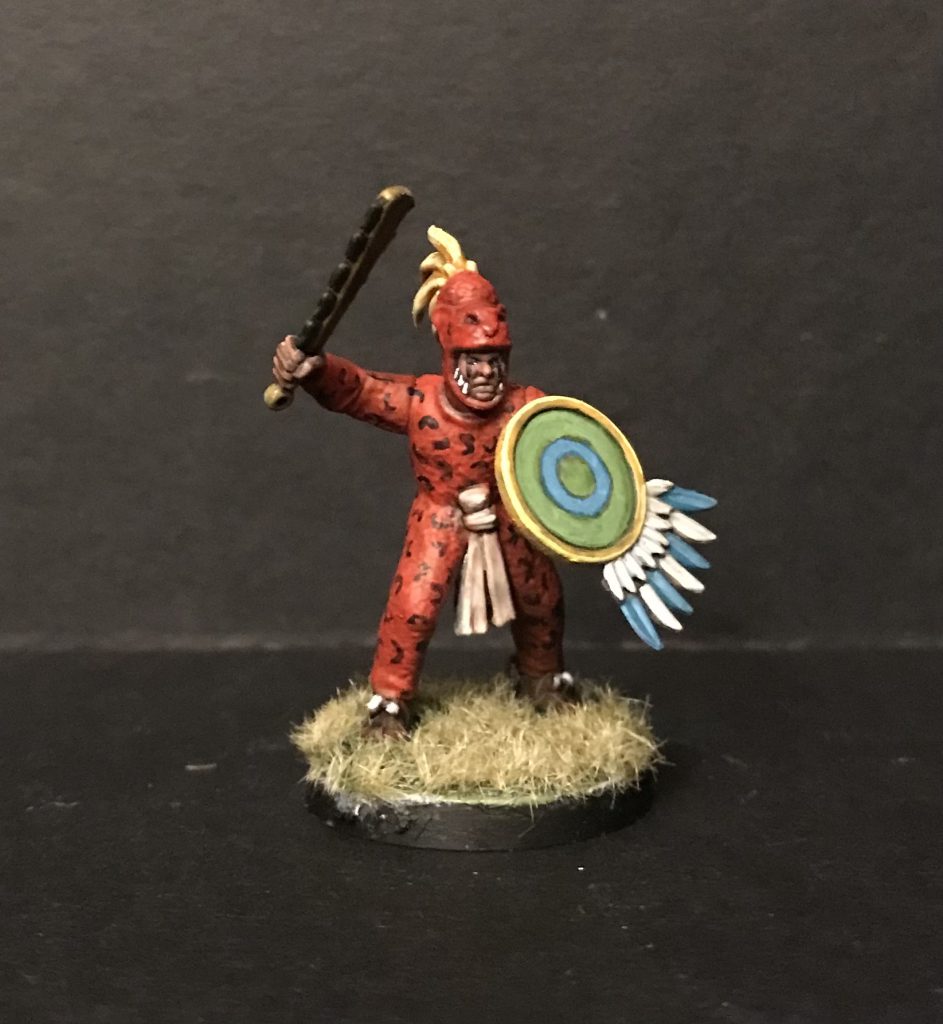
All war and warlike situations allowed this, but the Flower Wars most of all. They were not far flung campaigns, but fought against nearby Nahua cities – in the 13th and 14th centuries the Mexica fought them against the Chalca altepetl, today an hour’s drive from what was once central Tenochtitlan. They were not uncontrolled battles but time-limited and at least to some extent formalised. Many people participated, but it was a venue for individual prestige-generating actions. The aim was not to slaughter your enemy indiscriminately, but to support your own political and economic development. We can make a lot more statements with this information:
Fought against nearby altepetls, so we don’t need to think about logistics, just fighting
Battles were controlled, so we can have a round/turn limit
Many people participated, but the aim was individual prestige, so we have a limited number of models on the table
Individuals gained prestige based on their actions, so we should highlight individuals
Reading Hassig this began to pull many of the concepts together. We have an idea – to an extent – how the Mexica fought, how the Flower Wars were conducted (and why). You can see how we took elements of this research to build the core concepts of our design. Ludonarrative harmony seemed only a step away!
Xōchiyāōyōtl, not Flower War
Hassig is very much of his time though, and the study of Mexica Warfare and the flower wars has developed since the late 80s in line with modern history and anthropology, so our next stop was the Estudios de Cultura Nahuatl for some more modern research and especially an article by Stan Declercq– ““They Were Always Fighting for no Reason”: The Aztec Flowery War as an Indigenous Social Construction” (2020).

This is a really cracking article, even if my Spanish is so poor that I had to resort to about 90% machine translation to read it. The important revelation here, particularly for those of us very much looking at the Aztec Empire through the socially conditioned lens of “bloodthirsty warriors” was that the Flower Wars were a socially renewing and reconstructing phenomenon. They were carried out among close, related culturally linked city-states, not with the aim of killing their best and brightest in a war of a thousand cuts, but to create and recreate bonds of affinity, trading and proxy-kinship amongst enemies. A much more complex picture emerges, one where men are certainly fighting – and dying – but doing so within a far richer and deeper cultural context. The question we had, really, was why Flower Wars were “ritualised” – not about killing the most people or taking the most captives per se, but capturing and acting within a set context. It does make you wonder that if it was all about captives, why not just send the same warriors to some lightly defended altepetl and take as many as you fancy?
This more modern research suggests that wasn’t the point – or at least not the whole point of the Flower Wars. It’s controlled war, “Flowery” war in the Nahua sense of Flowery as something loaded with social, ritual, religious and aesthetic significance. It’s not just a war to get captives, it’s a war whereby your actions can renew or create new social relations, where your individual soldiers can become “Flowery” – beautiful, adored, godly, poetic, brave, strong, transitory – everything the culture valued. Flowers were a big fucking deal, and making a war “Flowery” brings the aspects of the flower to the conflict. We haven’t quite worked that out yet, but the game statements that came out of it point to some routes we could go down:
The Flower Wars were controlled but still violent, so we should have an accidental escalation mechanic
The warriors fought in the hope or aim of changes in their social context, so individuals should be important and capable of surprises
The Flower Wars were “Flowery” so we should highlight bravery, daring, strength and chance
Fought within the broad context of Nahua speaking polities, so we can use one kit and identical sides – for now, at least
Wrapping Up
Let’s have a look at the game statements we’ve arrived at in the course of this article. If we summarise and combine similar ones, we have:
The Flower Wars were important, controlled and planned, so actions in the game should be under player control and rely on player choice
Flower Wars were about tactics within a wider strategy, so our game should focus on tactics and the specific weapons and equipment used
Warriors fought in loose groups, with support and a ranked hierarchy, so our game should include those ranks and a support element
Battles were controlled, so we can have a round/turn limit and an escalation mechanic
Many people participated, but the aim was individual prestige, so we have a limited number of models on the table and highlight individual acts of bravery, daring and strength
The warriors fought in the hope or aim of changes in their social context, so individuals should be important and capable of surprises
Fought within the broad context of Nahua speaking polities, so we can use one kit and identical sides – for now, at least

That’s quite a lot to go on, but the basic structure is there. We have a small-scale skirmish game of individual combat, heroism and daring. We need to include round, support, escalation and rank mechanics and we can use one kit – the Wargames Atlantic Aztec Warrior box – for more-or-less identical sides. Everything should be about player choice and control, exploring not just the possibility space for this but also ideas around the restraint of violence to achieve specific ends. With these ideas in mind, we can go back to finishing off our game.
We’re in the early stages of playtest at the moment, so our design work is ongoing. If you’d like to see what we’re up to, our playtest alpha is available for our Patreon subscribers. If you have any comments, questions or suggestions, please get in touch via contact@goonhammer.com.


